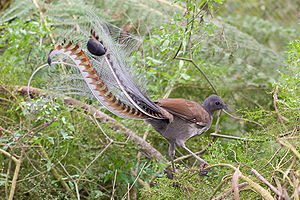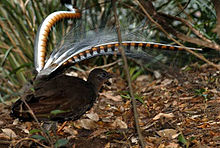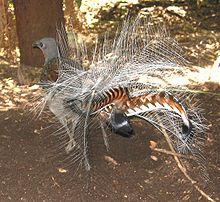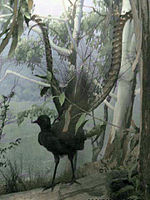- Superb Lyrebird
-
Superb Lyrebird 
Conservation status Scientific classification Kingdom: Animalia Phylum: Chordata Class: Aves Order: Passeriformes Family: Menuridae Genus: Menura Species: M. novaehollandiae Binomial name Menura novaehollandiae
Latham, 1801The Superb Lyrebird (Menura novaehollandiae) is a pheasant-sized songbird, approximately 100cm long, with brown upper body plumage, grayish-brown below, rounded wings and strong legs. It is the longest and third heaviest of all songbirds.
The Superb Lyrebird is featured on the reverse side of the Australian 10 cent coin.
Contents
Description
An Australian endemic, the superb lyrebird can be found in the forests of southeastern Australia, from southern Victoria to southeastern Queensland. Its diet consists mainly of small invertebrates found on the forest floor or in rotting logs. In the 1930s a small number were introduced to Tasmania amongst ill-founded fears it was in danger of becoming extinct. The Tasmanian population is currently thriving. Now widespread and common throughout its large range, the Superb Lyrebird is evaluated as Least Concern on the IUCN Red List of Threatened Species.
The male is the bearer of the most elegant of all tails. The tail has sixteen feathers, with the two outermost together forming the shape of a lyre. Next within are two guard plumes and twelve long, lace-like feathers, known as filamentaries. Seven years are required for the tail to fully develop. During courtship displays, the male inverts his tail over his head, fanning his feathers to form a silvery white canopy. Young males and females have brown tail feathers which are camouflaged against the forest floor.
Voice
The superb lyrebird has an extraordinary ability to accurately mimic a huge variety of sounds. Both male and female lyrebirds sing but males are louder and sing more often.
Mating habits
Superb lyrebirds breed in the depth of winter. Adult males start singing half an hour before sunrise from roosts high above the forest floor. Superb lyrebirds sing less often at other times of year but a stroll through their habitat on a rainy or misty day will sometimes find them active.
Superb lyrebirds have a promiscuous mating system. During the breeding season adult females and males defend separate territories and only females care for young. A female may visit several males before she mates [1]but it is not known if she mates more than once. The female lays a single egg and builds a domed nest often camouflaging it with ferns or moss.[2] The chick spends about nine months with the female before becoming independent.
Taxonomy
One of the two lyrebirds in the family Menuridae, the other being the much rarer Albert's Lyrebird,
The scientific name has been given as Menura superba previously.
Lyrebirds are ancient Australian animals. The Australian Museum has fossils of lyrebirds dating back to about 15 million years ago.[3] The prehistoric Menura tyawanoides has been described from early Miocene fossils found at the famous Riversleigh site.
Museum specimens
 John Gould's early 1800s painting of museum specimens of a male Superb Lyrebird and a female Superb Lyrebird
John Gould's early 1800s painting of museum specimens of a male Superb Lyrebird and a female Superb Lyrebird
John Gould's painting of a male and female pair of Superb Lyrebirds, painted from specimens at the British Museum, unfortunately has the tail feathers of the male incorrectly displayed.
A specimen of a male Superb Lyrebird, at the American Museum of Natural History, also unfortunately has the tail feathers displayed incorrectly.
References
- BirdLife International (2004). Menura novaehollandiae. 2006. IUCN Red List of Threatened Species. IUCN 2006. www.iucnredlist.org. Retrieved on 12 May 2006. Database entry includes justification for why this species is of least concern
- ^ Lill, A. 1979. Assessment of male parental investment and pair bonding in the polygamous superb lyrebird, Auk, (vol. 96, pg 489-498).
- ^ Higgins, P. J., Peter, J. M. & Steele, W. K. 1990a. Superb lyrebird. In: Handbook of Australian, New Zealand & Antarctic birds (Ed. by Marchant, S. & Higgins, P. J.), pg 142-173. Melbourne Oxford University Press.
- ^ Boles, Walter (2011). "Lyrebird: Overview". Pulse of the Planet. http://www.pulseplanet.com/archive/Dec02/2810.html. Retrieved 3 October 2011.
External links
- BirdLife Species Factsheet
- IUCN Red List
- Superb Lyrebird - Museum Victoria
- Superb Lyrebird - Healesville Sanctuary
- Lyrebird Forest - Healesville Sanctuary
- Superb Lyrebird - Australian Journal of Zoology
- Photos of Superb Lyrebird
- Superb Lyrebird photo - Trevor Quested
- Superb Lyrebird - Dr. Ellen Rudolph
- Superb Lyrebird photo and information - Sherbrooke Lyrebird Survey Group
- Superb Lyrebird videos on the Internet Bird Collection
- Superb Lyrebird - clip from David Attenborough's BBC program in which he watches a Superb Lyrebird
Categories:- IUCN Red List least concern species
- Menuridae
- Birds of Tasmania
- Animals described in 1801
Wikimedia Foundation. 2010.




